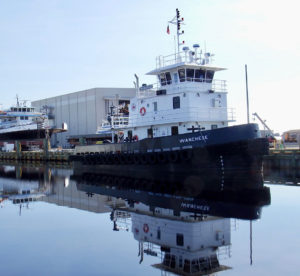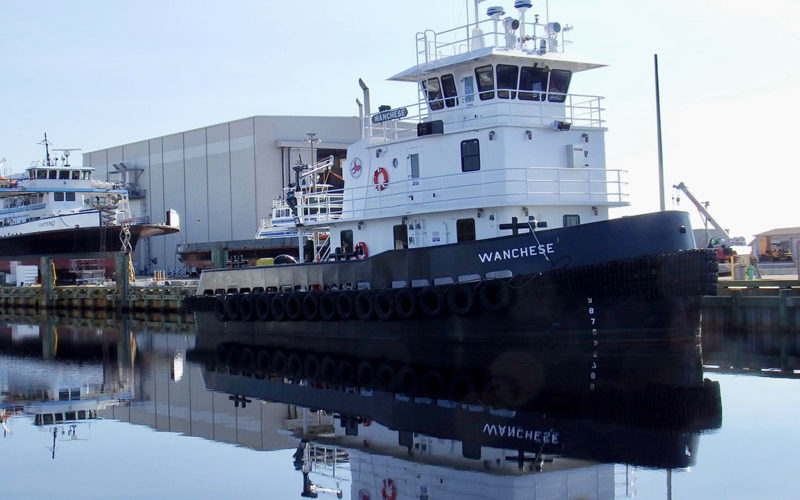
North Carolina Department of Transportation (NCDOT) welcomed the arrival of its all-purpose tugboat, Wanchese, to the Outer Banks.
NCDOT oversees a diverse infrastructure portfolio for rail, aviation, bus, motor vehicle, bicycle and pedestrian transportation. The department maintains 80,000 miles of road and 13,000 culverts and bridges, the longest being the five-mile Virginia Dare Memorial Bridge over Croatan Sound between Roanoke Island and Manns Harbor, headquarters for NCDOT’s North Carolina Ferry System (NCFS).
North Carolina operates the second-largest publicly owned ferry system in the United States. Its fleet includes at least 20 ferries and nine support vessels. Each year, the state ferries carry 850,000 vehicles and 2 million passengers on seven routes from 13 terminals. State ferries make approximately 200 trips per day, covering 1,200 miles over water.
Since 2020, NCDOT has upgraded a large chunk of its workboat fleet. Conrad Shipyard built three smaller workboats, and Metal Shark delivered Wanchese using a design from DeJong & Lebet of Jacksonville, Fla. Wanchese has a 71-by-30-foot model bow with a boxy inland-style deckhouse rising above the deck. Its large forward-slanting glass wheelhouse provides superb visibility in all directions from a 32-foot height of eye.
Named for a small town on the southern tip of Roanoke Island, Wanchese will replace the 58-foot conventionally driven tugboat Albemarle built in 1977. The biggest change between the two vessels can be found in the engine room: Wanchese is propelled by Schottel SRP 210 z-drives turning 57-inch propellers. Two 600-hp Caterpillar C18 engines provide the muscle. NCDOT tug operators noticed Wanchese has greater maneuverability and reduced fuel usage compared to its predecessor.
In addition to better maneuverability and power, Wanchese has a spacious deck with updated deck machinery — including a stern towing winch Albemarle lacked. The Coastal Marine Equipment hydraulic towing winch is essential on Wanchese, which serves as a first responder for ferries or other large vessels should they become disabled. The Wintech KR-series “push gear” deck winches on the stern are also hydraulic, replacing the manual winches found on Albemarle. Crews have been pleased with power equipment on a roomier deck with a larger workspace than the previous tug.
Wanchese is generally a day boat, but it is equipped with a FLIR system to assist with nighttime rescues for the ferry system or other operators. Wanchese’s intercom, another tool lacking on Albemarle, enables the wheelhouse to communicate with crew in the galley, bow and stern. The Garmin chartplotter/sonar combination with touch-screen technology provides a leap forward as well.
One imperative of the tugboat design process was a shallow draft, not to exceed 7 feet. This is necessitated by occasional conditions of low water, especially during blowout tides – a phenomenon that occurs when strong, sustained seaward winds blow water out of a waterway, causing unusually low tides. Furthermore, the shallow draft allows the tug and equipment to move into protected areas designated as “shelters,” such as Stumpy Point, N.C., during hurricanes and other strong storms.
Moving NCDOT marine assets wherever they are needed is Wanchese’s primary mission. These assets include Manteo, a 115-by-36-foot hydraulic pipeline cutterhead dredge built in 2016, and the crane barge Skyco, a 136-by-40-foot vessel with a 3-foot draft built in 2008.
Support craft like the dredge and crane are essential to safe and reliable movement of the ferries because their routes cross sounds and rivers inside the Outer Banks of North Carolina. Silting and shifting sandbars occur in all seasons but more acutely as a result of hurricanes and tropical storms. Without dredging equipment, the waterways would become impassable in short order.
Currituck Sound and Hatteras Inlet need constant attention, as do parts of the Albemarle-Pamlico Sound, the second-largest estuary in the U.S. after the Chesapeake with a north-south orientation. Within the Albemarle-Pamlico Sound, there is 80 miles of fetch encompassing six river basins, eight sounds and 3,000 square miles of open water. The state ferry system operates year-round, but ridership surges in warmer months when tourists travel between the Outer Banks and the mainland. The island of Ocracoke on the Outer Banks is accessible only by ferry or private vessel.
Wanchese is the prime mover in projects besides dredging. For instance, it moves equipment used to maintain ramps and gantries at terminals, as well as piling clusters, bulkheads and seawalls. The area served stretches from the northernmost ferry terminals supporting the Currituck-Knotts Island route to the terminals for the Southport-Fort Fisher route, more than 250 miles to the south.
The four-person crew of Wanchese operate the dredge and crane, keeping a 0600-to-1800 schedule on a seven-days-on/seven-days-off rotation. The tugboat has berthing for four crewmembers in two cabins. The galley, equipped largely with stainless-steel appliances, doubles as a recreation room.
Spring, summer and fall are busy times for the ferry system and the support crews. Lance Winslow, assistant director of NCFS marine asset management, is thrilled with the new boat. “Upgrades on Wanchese will make us more efficient, saving us time while getting better fuel economy on a bigger, safer platform,” he said.
Wanchese was built at Metal Shark Alabama, the former Horizon Shipbuilding yard located in Bayou La Batre. Wanchese is one of the first newbuild tugboats to leave the facility, which is focused on building and repairing steel-hulled vessels.
“We are honored to deliver this high-quality, purpose-built vessel to NCDOT,” said Doug Barrow, Metal Shark Alabama’s vice president and manager. “I am very proud of our team and all of our vendors for pulling together to make this delivery happen despite a very active tropical season on our Gulf coast, not to mention a worldwide pandemic.
“The challenges of social distancing and other safety and sanitation measures undertaken at our facility were met head-on and embraced by the entire team,” Barrow continued. “The result of these efforts can be measured by the fact that our facility did not have an outbreak, meaning that production – while impacted by COVID-19 protocols and materials delays – was able to continue.”
The Metal Shark team in Louisiana assisted with the prefabrication of aluminum deckhouse panels. The company’s engineering team met task deadlines adeptly while working in a remote environment, coordinated by on-site engineers in Alabama, he said.
The effective working relationship with NCDOT helped make the project a success. “The positive impact of NCDOT and its partnering approach cannot be overstated,” Barrow said.

